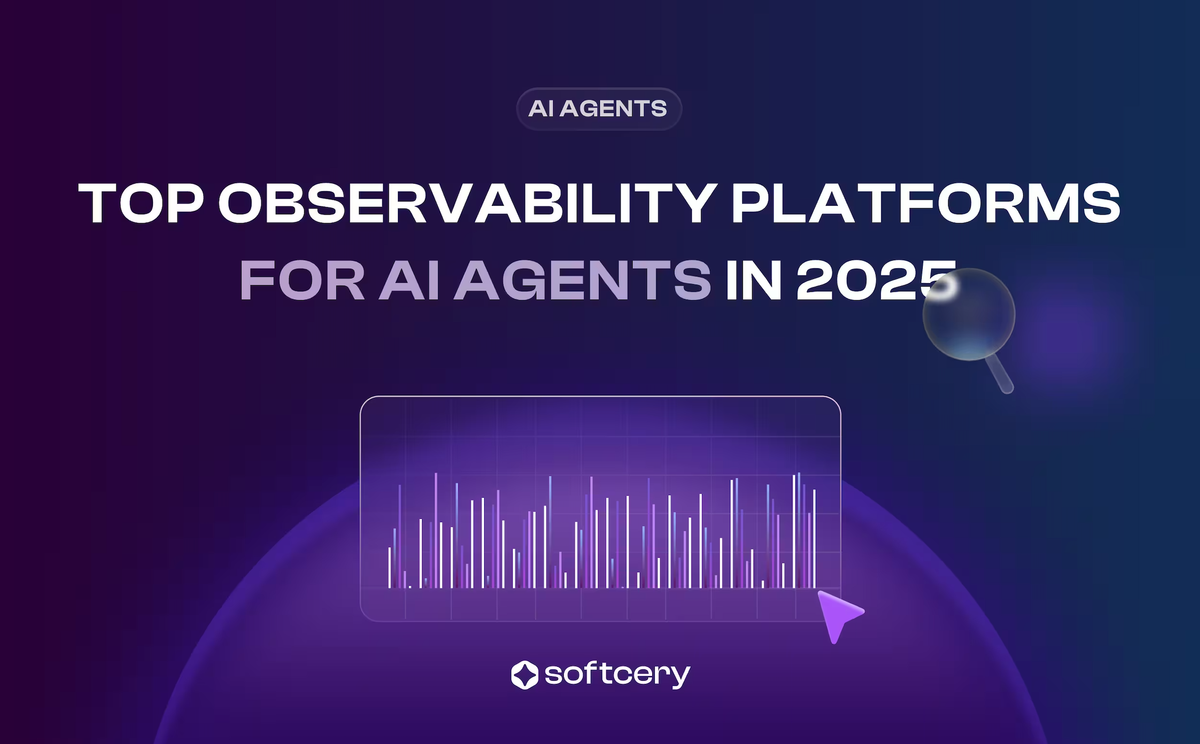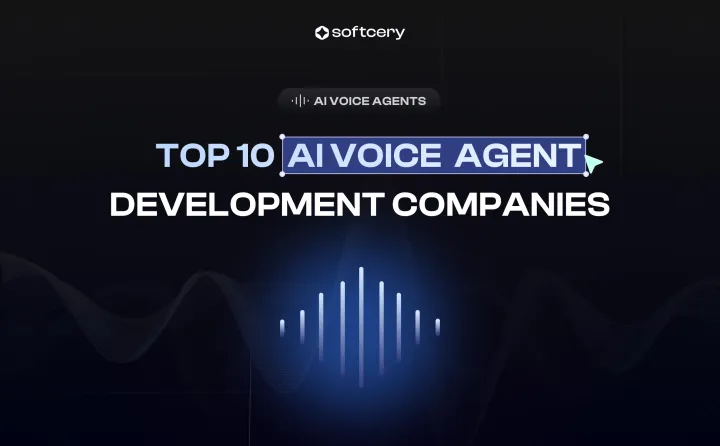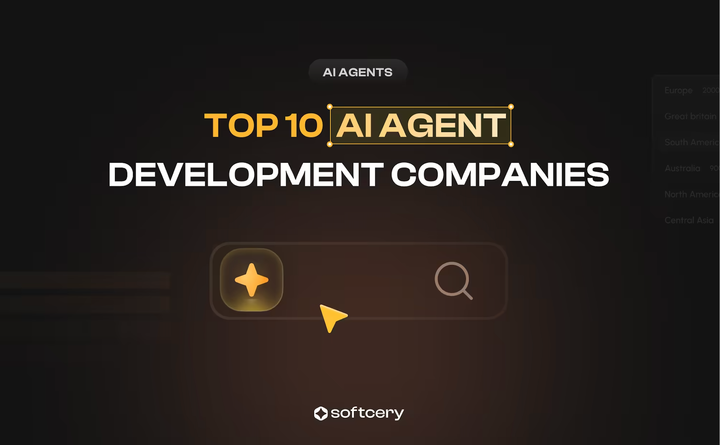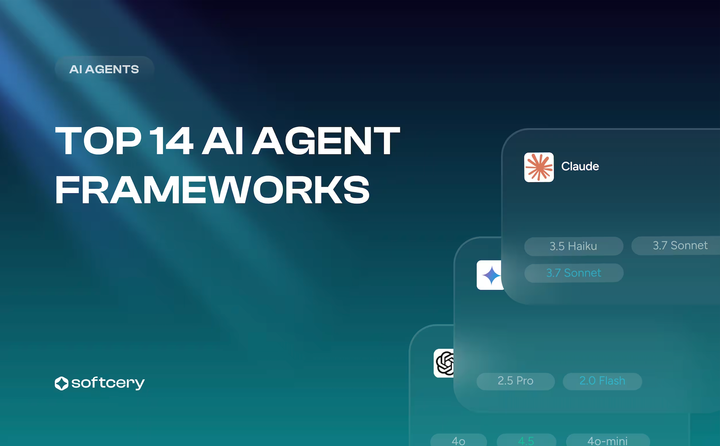
Top 8 Observability Platforms for AI Agents in 2025
Don’t wait for AI agent failures to cost you time or money. Discover the best 2025 observability platforms that let MVP founders and enterprises debug, track costs, and scale AI agents with confidence.
You can not debug AI behavior by reading logs or running unit tests. A model might respond flawlessly one day and produce irrelevant, biased, or costly outputs the next.
Solution? AI observability platforms , which track everything from prompt performance and latency to reasoning paths, token usage, and hallucination rates. The right tool can mean the difference between scaling confidently and firefighting mysterious failures after launch.
Softcery is here to help you out and break down the top observability and evaluation platforms for AI agents in 2025: everything from open-source frameworks to enterprise-ready solutions. You’ll learn which tools fit an MVP budget, which integrate seamlessly into existing monitoring stacks, and which are worth investing in as your product matures.
The AI Agent Observability Platform Landscape
Not all AI observability tools are built the same. Depending on your stage, budget, and technical capacity, the right choice will look very different. All platforms fall into three main categories:
Open Source / Self-Hosted
Phoenix, Langfuse, Lunary, OpenLIT, Traceloop
Tools are free to use, but you host and manage them yourself (on your own servers, cloud instances, or containers.)
- Best for: Technical teams comfortable managing infrastructure, founders minimizing recurring costs, or companies with strict data sovereignty needs.
- Tradeoffs: You’re responsible for setup, scaling, and reliability. Getting started takes longer than plugging into a SaaS dashboard.
- Typical cost: USD 0 for software, plus around USD 50–2,000/month for infrastructure depending on scale.
Commercial SaaS (Fully Managed)
LangSmith, Helicone, Braintrust, AgentOps, Datadog, Langfuse (Cloud)
These platforms handle everything for you: infrastructure, scaling, and updates. You simply connect via API and start tracking.
- Best for: MVP or post-MVP teams that want fast results without heavy DevOps work. You get dashboards, alerts, and support out of the box, which helps move faster during early growth.
- Tradeoffs: You’ll pay recurring fees that grow with usage and have less control over your data and integrations.
- Typical cost: Free tiers available, with startup plans around USD 25–500/month, and enterprise plans reaching USD 2,000–10,000+ per month.
Hybrid / Enterprise Solutions
HoneyHive, Arize AX, Maxim AI
These are the heavyweights of AI observability, offering multiple deployment options: cloud, hybrid, or fully on-premises.
- Best for: Large organisations, compliance-driven industries, or teams scaling mission-critical AI systems.
- Tradeoffs: Higher cost, longer onboarding, and often overkill for smaller startups.
- Typical cost: Custom pricing, typically USD 4,000–8,000/month minimum, or USD 50k–100k+/year.
Observability Tools' Integration Approaches
The way you connect an observability tool to your AI agent can completely shape your development journey. Each integration approach balances setup speed, control, and data depth, so understanding which one is best for you is essential.
Proxy-Based Integration
You route your LLM requests through a gateway rather than directly to the API provider.
For example, you change your API endpoint from api.openai.com to oai.helicone.ai. The proxy logs every request and response before forwarding them to the real model.
Why it matters: This is the fastest and easiest way to start monitoring your AI agent. You don’t need to change your code logic, just your API URL.
Setup time: Around 15 minutes, typically one line of code.
Tradeoffs: Adds a small latency overhead (50–80 ms) and provides less granular data compared to SDK-based tools. The proxy also becomes a single dependency for all your LLM traffic.
Best for: Teams that want quick visibility into cost and performance without major code changes.
SDK-Based Integration
This method uses an SDK (software development kit) that you install directly in your application. The SDK instruments your agent’s logic, capturing detailed traces and sends them to the observability platform.
Why it matters: You get deep insights into your AI agent’s internal behavior, which will help you debug reasoning issues, monitor complex workflows, and measure model performance more accurately.
Setup time: Several hours to a few days, depending on your codebase complexity.
Tradeoffs: Requires more setup and code changes but provides richer analytics and tighter integration with your development workflow.
Best for: Teams ready to invest engineering time for long-term observability and model improvement.
OpenTelemetry-Based Integration
This approach relies on OpenTelemetry, the open standard for collecting and exporting traces, metrics, and logs across distributed systems. You configure an OpenTelemetry collector and send your LLM traces to any compatible backend (Grafana, Datadog, Honeycomb, etc.).
Why it matters: Integration offers maximum flexibility and avoids vendor lock-in. You can integrate AI observability into your existing infrastructure rather than adopting a whole new platform.
Setup time: From a few days to several weeks, depending on your experience with OpenTelemetry.
Tradeoffs: The steepest learning curve and most configuration effort, but unmatched flexibility and control.
Best for: Teams with existing observability stacks or those building long-term, scalable AI systems.
Advice for MVP-Stage Founders: What to Look For in AI Observability Tools
When you’re building your first AI-powered product, every week and every dollar matters. The right AI observability tool should help you monitor, debug, and scale without slowing you down.
Here’s what to prioritise:
- A free tier you can actually use: Don’t settle for a “free trial” that expires in 14 days. Look for genuinely usable options. For instance, Helicone gives you 100K requests per month free, Phoenix is unlimited if self-hosted, LangSmith offers 5K traces monthly, and Langfuse Cloud, which Softcery currently uses for new projects, provides up to 50K events per month completely free.
- Setup time under a week: Your observability stack shouldn’t become a side project. Helicone can be set up in 15 minutes, and Phoenix in just a few hours, both ready for production. Langfuse also falls into the “easy start” category — its SDK-based setup typically takes only a few hours and delivers rich prompt and trace analytics out of the box.
- Cost tracking from day one: Token usage adds up fast, and it’s easy to lose track. Choose a platform that includes real-time cost monitoring and alerting. Most modern AI agent monitoring tools do, but don’t skip the setup — your budget will thank you later.
- Room to grow: Start lightweight, but make sure you can evolve. For example, you can begin with Helicone and later run Phoenix in parallel, or move from Phoenix to Arize AX for deeper performance analytics. Avoid solutions that lock you into one ecosystem early on.
8 Best AI Observability Platforms in 2025
Arize Phoenix
Leading open-source observability platform; enterprise upgrade via Arize AX.
- Core capabilities: Distributed tracing (OpenTelemetry), advanced evaluation (hallucination detection, relevance scoring), multi-step agent trajectory analysis, drift detection, supports 50+ LLMs and frameworks.
- Deployment: Docker (self-hosted), cloud free instance, enterprise with compliance and Copilot features.
- Pricing: Open source FREE; infrastructure USD 50–500/mo; Arize AX USD 50k–100k/year.
- Integration: Framework/LLM agnostic, moderate code changes, setup 2–4 hrs for Docker, 1–2 weeks for production.
- Strengths: Open source with no limits, production-ready, strong evaluation, clear enterprise upgrade path.
- Weaknesses: Requires technical setup, learning curve with OpenTelemetry, less focus on operational metrics.
- Best for: MVP-stage founders with technical teams seeking production-ready monitoring without vendor lock-in.
- Softcery recommends Langfuse based on our own experience: we currently use it for new projects because it’s easy to start with (cloud setup takes minutes), and the free tier covers up to 50,000 events per month at no cost.
LangSmith
LangChain’s official observability platform for debugging LangChain workflows.
- Core capabilities: End-to-end tracing, prompt/tool capture, step-through debugging, token/latency/cost metrics, dataset management, prompt versioning.
- Deployment: Cloud, hybrid (SaaS control plane + self-hosted data), enterprise self-hosted.
- Pricing: Free (1 seat, 5k traces/month), Plus USD 39/user/mo, trace overages USD 0.50–5/1k traces, enterprise custom.
- Integration: Native LangChain (minimal code changes), limited outside LangChain. Setup ~30 min.
- Strengths: Best for LangChain users, excellent prompt management, dataset evaluation.
- Weaknesses: LangChain lock-in, closed source, can be expensive at scale.
- Best for: MVP-stage founders deep in LangChain wanting fast, comprehensive visibility.
Helicone
Proxy-based observability with one-line integration, flat pricing.
- Core capabilities: Logs requests/responses, caching, cost tracking, rate limiting, custom properties, 100+ LLMs supported.
- Deployment: Cloud (Cloudflare workers), self-hosted optional.
- Pricing: Free 100k requests/mo; Pro USD 25 flat (unlimited requests).
- Integration: Change API base URL; 15-min setup; 1–2 lines of code.
- Strengths: Fastest time-to-value, flat pricing, low latency, generous free tier.
- Weaknesses: Limited evaluation, less depth than SDK-based, proxy dependency.
- Best for: MVP founders needing fast setup, predictable costs, basic monitoring.
Langfuse
Open-source platform for prompt management and collaborative development.
- Core capabilities: Prompt tracking/versioning, execution traces, dataset evaluation, token/cost tracking, user feedback collection.
- Deployment: Self-hosted (free), cloud (tiered pricing, up to 50k events/month free). Requires ClickHouse, Redis, S3 for self-hosting.
- Pricing: Free (self-hosted), cloud Pro/Team tiers USD 500+/mo.
- Integration: SDK-based, OpenTelemetry compatible; setup 4–8 hrs cloud, 1–2 weeks self-hosted.
- Strengths: Fully open source, strong prompt version control, collaborative features.
- Weaknesses: Complex infrastructure, cloud paid tier expensive.
- Best for: Teams focused on prompt engineering and iterative development.
- Softcery recommends: Langfuse is the platform Softcery actively uses for new projects — it’s easy to start with, free up to 50k events/month, and supports both self-hosted and cloud options.
Datadog LLM Observability
Enterprise APM vendor’s specialized LLM monitoring.
- Core capabilities: Full-stack tracing, latency/cost/error metrics, security scanning, hallucination/drift detection, CI/CD integration.
- Deployment: Cloud-only SaaS; integrates with existing Datadog.
- Pricing: Enterprise only, USD 20k–100k+/year.
- Strengths: Comprehensive integration, strong security/compliance, correlates with infrastructure metrics.
- Weaknesses: Expensive, overkill for startups, cloud-only.
- Best for: Post-MVP/enterprise companies with Datadog.
AgentOps
Python SDK for AI agent monitoring with time-travel debugging.
- Core capabilities: Visual event tracking, session replay, cost tracking, full data trail, multi-agent support.
- Deployment: Cloud-only.
- Pricing: Free trial 1k events, Pro USD 40/mo, enterprise custom.
- Integration: Python SDK, 1 hr setup, moderate code changes.
- Strengths: Specialized for agent workflows, time-travel debugging, good cost tracking.
- Weaknesses: Python-only, smaller ecosystem, limited evaluation features.
- Best for: Python developers building multi-agent systems needing deep debugging.
Braintrust
Evaluation and observability platform with AI agent (Loop) for optimisation.
- Core capabilities: Dataset evaluation, prompt/model A/B testing, Loop AI agent for automated optimisation, Brainstore DB, production monitoring.
- Deployment: Cloud, hybrid for enterprise.
- Pricing: Free for academic/OSS, paid tiers contact sales.
- Strengths: Strong evaluation, automated prompt optimization, fast queries.
- Weaknesses: Pricing opacity, more evaluation than monitoring, newer platform.
- Best for: Teams prioritizing systematic evaluation or academic/research projects.
Lunary
Production toolkit with security focus and automatic output categorisation.
- Core capabilities: Conversation/feedback tracking, real-time analytics, prompt versioning, auto-categorisation (Radar), dashboards, LLM firewalls, PII masking.
- Deployment: Hosted cloud or self-hosted.
- Pricing: Free 10k events/mo; Team USD 20/user/mo.
- Strengths: Unique auto-categorisation, strong security/compliance, easy setup.
- Weaknesses: Smaller community, limited features vs. enterprise, free tier limited.
- Best for: MVP-stage teams needing affordable monitoring with security/PII handling.
AI Agent Observability Decision Framework
Use this framework to quickly pinpoint the tools that match your needs and get your AI systems running reliably from day one.
Choose Based on Your Primary Need
- Helicone: Built-in caching saves money immediately, flat $25/mo pricing.
- Langfuse: Better for prompt engineering focus; also available in the cloud with a generous free tier (50K events/month). Softcery actively uses and recommends it for new MVPs.
- AgentOps: Tracks 400+ LLMs, cost optimisation features, claims 25x reduction in fine-tuning costs.
Why: Prevent surprise bills, optimise token usage patterns.
- LangSmith: 30 minutes setup if using LangChain.
Why: Native integration, best debugging experience, zero code changes. Tradeoff: Framework lock-in, limited value if you switch away from LangChain.
- Braintrust: Loop AI agent for automated optimisation, systematic dataset evaluation.
- Confident AI: 40+ research-backed metrics, component-level evaluation.
Why: Systematic testing, quality metrics, regression detection. Tradeoff: Less focus on operational monitoring.
- Phoenix: Easier setup (single Docker container), OpenTelemetry standard, strong evaluation.
- Langfuse: Better prompt management, MIT license, collaborative features.
Why: Control over data, no recurring platform costs, avoid vendor lock-in. Tradeoff: Infrastructure management overhead.
- AgentOps: Time-travel debugging, multi-agent workflow visualisation, session replay.
Tradeoff: Python-only, cloud-only, smaller ecosystem.
- HoneyHive / Arize AX: SOC 2, HIPAA, GDPR compliance out of the box, enterprise deployment options.
Tradeoff: Expensive (USD 50k+/year), longer sales cycles.
- OpenLIT / Traceloop: Works with Prometheus/Grafana/Jaeger, OpenTelemetry standard, no new platform to learn.
Tradeoff: More configuration needed, less LLM-specific features.
Choose Based on Your Budget
- Phoenix: Best overall, production-ready, strong evaluation
- Langfuse: Better for prompt engineering focus
- OpenLIT: If you have existing Prometheus/Grafana
Tradeoff: Infrastructure management (expect USD 50-500/mo for hosting).
- Helicone Pro: USD 25/mo, unlimited requests, best value
- AgentOps Pro: USD 40/mo, 10k events, time-travel debugging
- Lunary Team: USD 20/user/mo, security features
Best for: Solo founders, small teams with modest request volumes.
- LangSmith Plus: $39/user/mo for small teams (5-10 people)
- Langfuse Cloud Team: $500/mo, full features, managed
- Helicone Pro + Phoenix self-hosted: Multiple tools combined
Best for: Small technical teams scaling past MVP.
- Langfuse Team: + additional tools for specialized needs
- LangSmith: for larger teams with trace volume costs
- Phoenix self-hosted: with production infrastructure
Best for: Post-MVP companies (10-100 customers), Series A stage.
- HoneyHive, Arize AX, Datadog: Enterprise solutions
- Multiple specialized tools: Best-of-breed stack
Best for: Series A+ companies with enterprise customers. Not recommended for MVP-stage unless compliance requirements force it.
Choose Based on Your Team
- Helicone: easiest setup, least maintenance
- Alternative: Phoenix if comfortable with Docker
Why: Minimize time on infrastructure, maximize time on product.
- Phoenix: self-hosted, team can manage infrastructure
- Alternative: Helicone Pro for speed over control
Why: Technical capability to self-host, benefit from cost savings.
- LangSmith (if using LangChain) or Helicone (simplest overall)
- Avoid: Self-hosted solutions requiring infrastructure management
Why: Managed service, support available, simple setup.
- Phoenix + Langfuse: best of both worlds
- Alternative: OpenLIT integrate with existing observability
Why: Can handle infrastructure complexity, want maximum features and control.
- HoneyHive, Arize AX, Datadog: enterprise solutions
Why: Compliance features, dedicated support, enterprise SLAs.
Choose Based on Your Timeline
- Helicone: 15 minutes to monitoring
- Verify logs appearing
- Set cost alerts
- LangSmith: 30 minutes (LangChain users)
- AgentOps: 1 hour
- Production-ready by end of week
- Phoenix: 2-4 hours setup, 1 week to production-ready
- Langfuse: 4-8 hours to 1-2 weeks for infrastructure
- Time for proper testing, alerts, dashboards
- HoneyHive, Datadog: 1-4 weeks
- Sales process, evaluation, integration
- Training, rollout, optimisation
Key Takeaways
1. Observability Isn’t Optional
AI agents fail differently than traditional software: outputs vary, reasoning chains break, costs spike, security risks appear. Without monitoring, the first signal is customer complaints; debugging takes days. Add observability before launch, not after. A one-week setup prevents weeks of firefighting.
2. Production-Ready Options Exist for Every Budget
There are options that are forever like Phoenix, Langfuse, and options for enterprise Datadog, Arize AX, HoneyHive .
3. Start Simple, Upgrade Later
Basic monitoring catches 90% of issues. Helicone takes 15 minutes, Phoenix 2–4 hours. Add complexity only when needed. Upgrade paths exist: Helicone → Phoenix → Arize AX.
4. Cost Tracking Pays for Itself
Observability platforms cost USD 0–500/mo for most startups. Monitoring token usage and query patterns saves hundreds to thousands. Helicone caching alone can offset platform costs. Catch expensive patterns before they hit your bill.
FAQs:
- Do I really need observability before launch?
Yes. Adding observability before launch takes one week. Debugging production issues without it takes weeks. When a customer reports "the agent gave me wrong information yesterday," you need to see exactly what happened. Without traces, you're guessing based on vague descriptions.
Free options exist (Helicone gives 100k req/mo free, Phoenix is unlimited self-hosted). Budget isn't an excuse. The gap between demo-ready and production-ready is where observability matters.
- How much should I budget for observability?
- Pre-MVP: USD 0 (Helicone Free or Phoenix self-hosted);
- MVP to early traction: USD 25-200/mo (Helicone Pro at $25/mo is best value);
- Scaling (100+ customers): USD 500-1,500/mo (managed solutions or production self-hosted);
- Series A+: USD 2,000-10,000/mo (enterprise compliance requirements)
Cost optimization through observability often saves more than the platform costs. Helicone caching can save USD 100s/month. Identifying expensive query patterns saves thousands.
- What's the difference between monitoring and evaluation?
Monitoring tracks operational metrics: Did requests succeed? How long did they take? What did they cost? Tells you something broke.
Evaluation measures quality: Is the output accurate? Is it relevant? Are there hallucinations? Tells you why quality dropped.
AI agents need both. Monitoring keeps system running. Evaluation keeps system correct. Most platforms offer both, but emphasis varies (Helicone focuses on monitoring, Braintrust focuses on evaluation, Phoenix balances both).
- Should I self-host or use a SaaS platform?
Choose SaaS if:
- Solo founder or small team without DevOps capacity;
- Need fastest possible setup (launch this week);
- Prefer predictable costs over infrastructure management;
- Don't have data sovereignty requirements.
Choose self-hosted if:
- Technical team comfortable with Docker/infrastructure;
- Want to avoid recurring platform costs (USD 25-500/mo → USD50-200/mo infrastructure);
- Have compliance requirements (data can't leave your infrastructure);
- Want maximum control and no vendor lock-in;
- Both are production-ready. Phoenix self-hosted is as reliable as commercial SaaS once properly deployed.
- Do I need different observability for chat agents vs voice agents?
Core needs are same (cost tracking, traces, quality evaluation), but voice agents add:
- Real-time requirements: Voice needs <500ms response latency. Monitor p95/p99 latency carefully.
- Multi-modal traces: Track STT (speech-to-text), LLM reasoning, TTS (text-to-speech) as separate steps. Need observability that handles this pipeline.
- Audio-specific metrics: STT accuracy, TTS naturalness, interrupt handling, turn-taking patterns.
All major platforms (Phoenix, LangSmith, Helicone) handle voice agents. Focus on latency monitoring and cost tracking across the full STT-LLM-TTS pipeline.



